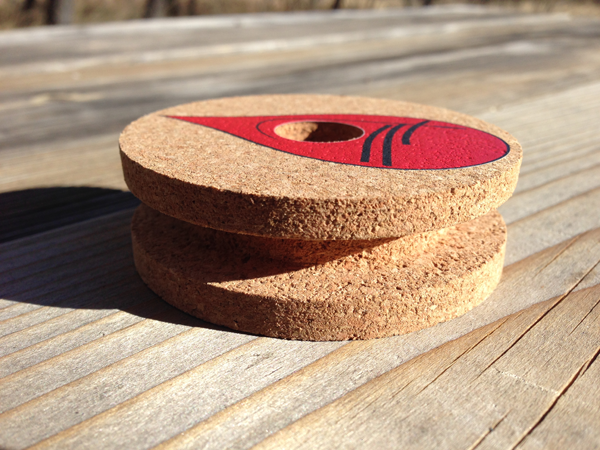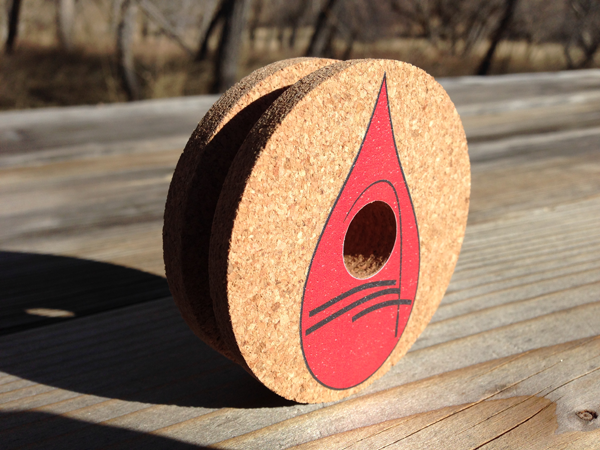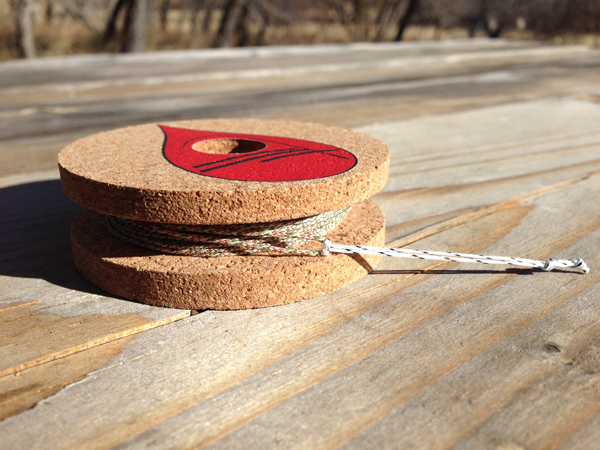Most tenkara line spools I’ve tried have been either plastic or wood, so I was intrigued when I saw the spools from Tenkara Pyrenees that are made entirely of cork. I liked the idea since a.) it’s unique, b.) it floats, and c.) the entire spool is made from a material that lets you stick the fly anywhere you want–simplifying line winding process.

The spool is a natural cork color with the Tenkara Pyrenees logo on one side and a center hole that is big enough to fit down the blank of any tenkara rod and to even accommodate an index finger (which facilitates winding). The cork is very comfortable and secure to grip, even when wet or in the cold. And at a diameter of 2.75″ (70mm) and width of 0.79″ (20mm), the overall size is extremely ergonomic.

All in all, this is a very attractive and practical spool that just feels cozy to use. At 0.4 oz., I think it’s probably one of the lightest out there and definitely has more charm than its plastic counterparts.
My only question is why they omitted notches to secure the end of the line once you’re finished winding the line. Without them, the line can (and by “can” I mean “will”) unravel. Luckily, the cork is easy to work with and I think I will cut about six notches in the top rim of the spool to secure the end of the line.
If you’re interested in these spools, check out the Tenkara Pyrenees website.









But can you order it and get it in the USA? And is the shipping more than the spool itself?
Brian
can’t tell from the pic, but is it natural cork or synthetic or substitute? It appears to be, and I sincerely hope it is, one of the latter two, since I’d hate to see someone wasting good cork on winders.
Hi Craig, I once asked Tenkara no Oni why he uses foam for his grips instead of cork. He cited environmental reasons but when I brought this into the discussion, many people replied back that cork is actually more environmentally friendly and sustainable. I’ve always heard that there is a cork shortage but others said that’s not true. I’m not an expert so I’m not sure which side is correct. But I think Christophe makes some good points that cork is probably better for the environment.
This spool is by far my favorite one! I do not see this excellent accessory as a waste of good cork as cork being a renewable resource
which is not the case of plastic spools whose the main ingredient is pollutant waste. And in case you lose it it is biodegradable!
You are right Jason about the notches they are to be done by the angler himself so one can do it the way he wants.
Thanks for the picture Christophe. Did you just use a knife to make the slits?
It’s also very easy to enlarge the center hole with a wood file to fit every tenkara rod
Great post, thanks for the link to Tenkara Pyrenees, pretty good site,some great videos. I have heard that their is a shortage of natural cook as most of it is used to cork wine bottles. Not sure of that as the wine I drink comes in a twist-off bottle or jug!!
It looks like the spools are made up of cork chips, a byproduct of manufacturing other cork products. The chips are pressed back together into large sheets and blocks to be used for other products. It’s a good way to recycle leftover scraps that would otherwise end up in the landfill.
Also. There is no cork shortage. In fact, based upon current estimates there is enough cork to close all wine bottles produced in the world, for the next 100 years. The cork forests are now being more sustainably managed than ever before in their history and new planting is always ongoing.
JD, thanks for those last two comments. You always bring something enlightening to the conversation.
Thanks to the pioneering Australians, more and more quality wine is being bottled with the twist-off metal caps (recyclable?) and not corked.
Jason ,
It looks like a thumb tack in the side might work for holding the line .
Darcy, Hmmm, actually, that sounds like a really good idea. I’ll try it. Thanks!
I knew my post would be provocative. since I am argumentative tonight, to add more petrol to the fire (pun intended):
i suggest that if you really are buying these for environmental reasons, then you should look into a bamboo rod instead of one comprised of carbon and petrochemicals aka carbon fibre/epoxy resin & glue, and use horsehair instead of petrochemical=based line aka mono/fluoro, and think about riding a horse to the river instead of driving a petrochemical guzzling car on petrochemical compound tires and full of petrochemical interior.
now, the larger pic shows a glued composite cork chip material, and glue is made from petrochemicals. whether it is actually less of a footprint or not will depend on how the cork was sourced, whether it was recycled and how, or whether it required more land clearing, how and where it was made and shipped. a lesser footprint line winder would definitely be a stick or piece of bone you find on the side of the river and carve yourself.
I’m not suggesting that one adopts any of this, just pointing out there are some omissions of fact being made in claiming a glued cork composite spool is superior to other alternatives.
Well nice try anyway Craig. But when there are certain industries that have carbon footprints the size of entire countries even multiple countries, I can’t feel guilty for buying a recycled spool or plastic rod.
Blame it on Rockefeller. Hahahaha
Or better yet blame it on Dow or Alexander Parks or John Hyatt.
Haha Craig I’m just messin around.
Jason, I used a box cutter to make the slits and a pen to mark their location. I understand your arguments Craig but I personally think that there are surely less polluting chemicals in this composite cork spool that in any plastic one. I still wonder why so many anglers have developed a fetish for high end cork! It does not bring anything else than aestheticism.